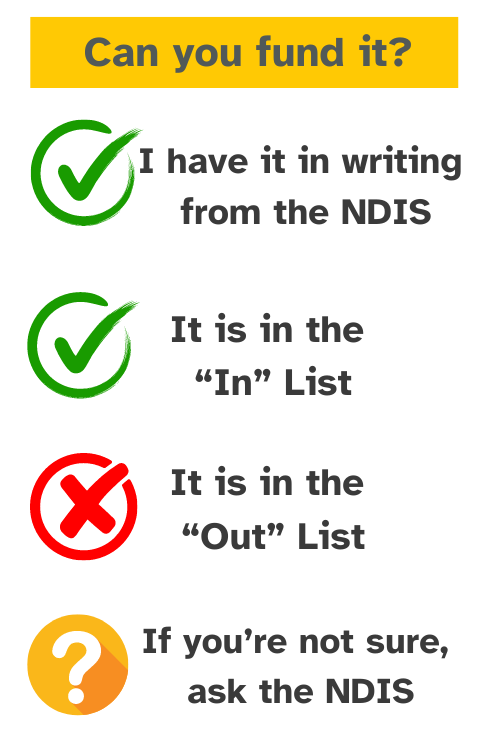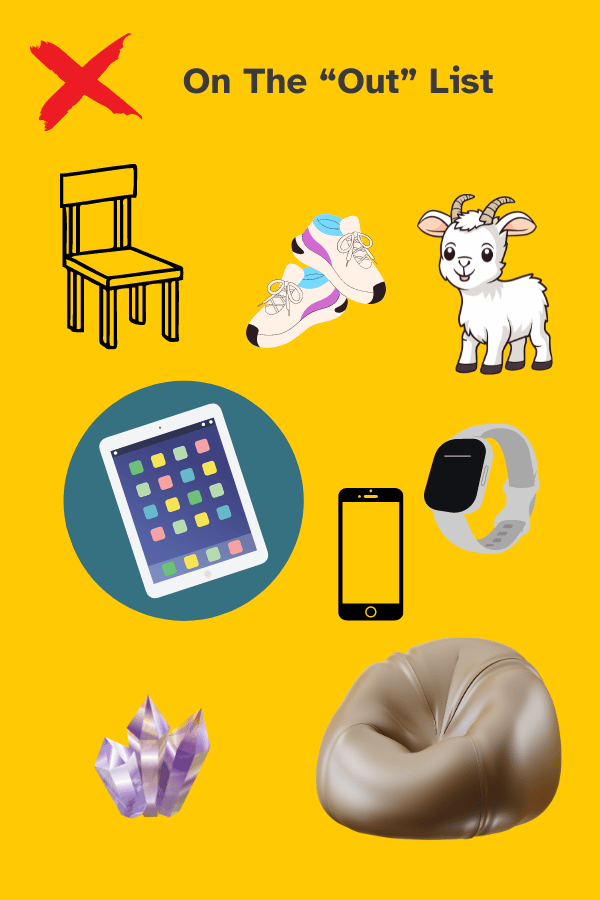By now, you’ve probably heard a lot about the new NDIS “lists” – detailing what is an NDIS support, and what isn’t. Most of us have received emails and text messages, reassuring us that the NDIS is aware that these changes can cause some anxiety (ya think?) but that it’s ‘business as usual’.
If you feel completely reassured by this and have no anxiety or questions about the new lists whatsoever, then please return to your usual Netflix / Tik Tok programming, as the rest of this post isn’t for you!
If, however, you’ve been confused by conflicting and contradictory Facebook posts, or media articles about how spa baths, trips overseas and goat therapies are now no longer funded (I think some of us missed out on those perks), then read on! You might want to grab a cuppa (or a friend to keep you awake) however, as it’s quite a looooong read…
The Reality
As a plan manager, we wade through a sea of ‘grey’ to find out what the NDIS has said about certain supports. Sometimes, there’s wonderfully clear information put out by the NDIS: “No, you can’t use your current funding to buy a weighted blanket”. Then there’s information which just leaves us with more questions – “Typically, the NDIS does not fund sensory items”. That last one is a whole new blog post by itself!
Quite often however, the NDIS has not given explicit information as to when a participant can use their funding to buy a particular product or support. Then it comes down to knowing what the NDIS has said in the past, interpreting similar guidelines, using our own personal knowledge from NDIS dealings, and looking at the individual’s situation and needs. This is why some plan managers will pay for Product XYZ, and others won’t.
The new lists are designed to put an end to all of that, as they lay out in black and white what an NDIS support is, and what it isn’t. Everyone – participants, providers and plan managers – now has to consult the lists to make sure that plan funding is only used on an NDIS support. Sound great? Read on!
So What Can I Spend My Funding On?

Here’s your checklist to figure out whether you can use a particular service or buy a particular product:
- Is it written physically into your plan, or determined by the AAT? Great – nothing changes. If your plan says you can’t use your funding for a particular purpose, that still applies as well.
- Is it in the list of ‘Supports that are NDIS supports’ (the “In” list)? Great – keep going as you were.
- Is it in the list of ‘Supports that are not NDIS supports’ (the “Out” list)? – Sorry, unless you’ve got it in writing from the NDIS or the AAT that you are allowed to use your funding in this way, you cannot claim it from the NDIS.
- Is it not mentioned in either list? It may be covered in a broader category, such as ‘Standard household items’, so check both lists for general items that may cover it.
- If your support doesn’t meet any of the above, you should get further advice from the NDIS around whether it is claimable for you. Be prepared for this to take quite some time, so think ahead!
The NDIS will fund supports that are necessary solely because of your disability. If it is a support that everyone needs (like a toothbrush or clothing) then you can’t claim it from your NDIS plan. If, however, you need disability specific, or adapted items because of your disability (such as adaptive cutlery), then you can use your plan to fund them.
The problem of course, is that it’s not always clear exactly when a particular item is specifically disability related and when it isn’t. If you are buying something that is readily available off the shelf and is used by those with a disability and those without, then chances are it’s not a disability specific / adapted item.
In the past, plan managers have often had to rely on therapists to explain when a participant required what could be an ‘everyday’ item or service, directly as a result of their disability. Under the new rules, you cannot buy something that is on the “Out” list, even with a letter of recommendation from your therapist. You can only buy something in the “Out” list if you have it written into your plan, or you have an email from the NDIS / AAT to say that you are allowed to use your plan funds to buy it.
My Support / Product Is In The “Out” List – Help!
What do you do if you need to purchase something with your NDIS funds that is directly related to your disability, but is now in the “Out” list?
If you have something in writing from the NDIS that specifically mentions that support as being claimable, you can still buy it. Send a copy to your plan manager, or keep it on hand if you’re self-managed. You’re good for your current plan, but will need to make sure you have it in writing for all future plans where you need that support.
If you don’t have it in writing, get onto your NDIS planner or Local Area Coordinator (LAC) and ask if they can give you something in writing. LACs don’t have the authority to decide what is a reasonable and necessary support, but they are able to access information in the NDIS database, where it may have already been written down. If your LAC sends you an email telling you that your support is claimable, they will also need to tell you under what basis they are advising you of this. If it’s in your file notes with the NDIS, or if it’s in a document they can access, they need to state this clearly in their reply.
If you can’t get it in writing, then you can’t claim it. You will need to contact the NDIS either directly or via your planner, LAC or support coordinator, and discuss this with them. You may need to apply for a plan review to have the supports written into a new plan. Be aware however, that the NDIS is majorly behind in assessing plan reviews, and is currently taking 6-8 months to action them.
Future Proofing Your NDIS Plan
If you need a support that is in the “Out” list, or open to interpretation (or not covered at all), you will need to always have it in writing that you can use your funds to claim for it. Every new plan you get, make sure that it is written into your plan. If it is accidentally left off a new plan, get onto the NDIS straight away and ask them to fix it.
The lists right now are temporary, and will change once the states and territories have agreed on what they think NDIS supports should be. Until then however, make sure that you’ve covered yourself by having it in writing that you are allowed to use your funds this way.
I’ve Used My Funds For Supports On The Out list – Now What?
The NDIS has given providers (including plan managers) a 30 day ‘grace’ period to get used to the new rules. Participants have 12 months to adapt. They haven’t explained why there’s a difference (because that would be far too helpful), but we ‘think’ this means that if you are self-managed, you have 12 months before they are going to crack down on you, but everyone else has 30 days.
After that grace period, the NDIS will ‘work with you’ to point out if you’ve used your funding when you shouldn’t have, and may also raise a debt against you. They will give you a couple of strikes before cracking down on you – as long as the support is not fraudulent, illegal and is less than $1,500.
It’s important to note that they’ve said this to participants, NOT plan managers. Plan managers don’t get a system of ‘three strikes’. This means that if you ask them to put through something in the ‘Out’ list, the plan manager is financially liable for it. The NDIS can choose to ask the plan manager (or the participant) to repay monies for anything at any time, if they deem that NDIS funds should not have been used.
At OnTime Plan Services, we spend a lot of time helping our participants safeguard their funding. This means monitoring for possibly fraudulent claims from providers, watching out for accidental mistakes by providers in their invoices, and letting our participants know if their claims could land them in trouble with the NDIS.
You may even have received an email from us, letting you know that the NDIS may not agree with your (or your therapist’s) decision that a particular product was disability related and reasonable and necessary. We may have given you some NDIS links and also let you know that the NDIS could ask you to repay the money. We do this not because we want to stop you getting your supports, but because we don’t want you to be sent a bill by the NDIS.
The new lists make a lot of these supports clearer, but there is still uncertainty on some items. We’ve gone through the lists, and picked out some supports below that our participants have used in the past, usually with a letter of recommendation from their therapist. If you don’t have these supports authorised in writing, we now have to ask you to contact the NDIS to get written permission, before we can process your claim.

On the “Out” list:
- Standard home repairs, maintenance. The “In” list specifies house or yard maintenance however. We don’t get it either…
- Standard household items – listed examples are beanbags, bedding, kitchen items etc. We’re pretty sure this also includes headphones and organisational equipment. We will seek clarification for face masks used when you are ill and hand sanitizer.
- Standard furniture, fixtures or fittings.
- Phones, plans and data, tablets and smart watches. The “In” list specifies assistive products to support communication and information management are claimable – read more about this below.
- Conference tickets – even if these are disability specific conferences.
- Sunscreens – if it is disability related you will need to have it written into your plan.
- Standard clothing and footwear
- Pet insurance (even if it’s for an NDIS funded assistance animal). Get this written into your plan if you have it approved.
- Parenting Programs (even if they are disability specific programs)
But I Use A Tablet With An App As A Communication Device!
You’ll note that Tablets are on the NDIS “Out” list, but a communication device is claimable. So what happens when you use an iPad with (for example) Proloquo2go as a Communication Device due to your disability?
The NDIS makes some exceptions to their “No” supports with what they have called “Replacement Supports”. From their website:
When we say replacement support, we mean the service, item or equipment you would like to use instead of the NDIS support or supports in your plan. Only some supports can be replaced and only if we agree in writing can you can buy this support. A replacement support isn’t an extra support. It replaces an existing NDIS support or supports in your plan.
One of these Replacement Supports is a Tablet, so you can apply to the NDIS to replace a disability specific communication device with a Tablet instead. You have to meet certain criteria to request this (check their website), and it’s up to the NDIS to decide whether they will approve it. If they say No, you cannot appeal that decision. So, if you rely on your iPad as a communication device, make sure you get it written into your plan that your funds can be used to purchase a replacement if needed!
Hopefully that has helped answer some questions you might have had about the new support lists. If you have any questions that are specific to your individual circumstances, you should get in touch with your LAC, support coordinator or the NDIS and request written advice.
Links
We have included a couple of links above, but here they are again, plus a few extras for those who like to do in-depth research:
https://www.ndis.gov.au/changes-ndis-legislation – this is the ‘why’, ‘how’ and ‘what’ of the new changes to the NDIS Act.
https://ourguidelines.ndis.gov.au/would-we-fund-it/what-does-ndis-fund – this is where you will find all of the lists (including Easy Read versions). As the NDIS can update anything at any time, we have linked the page, rather than each individual list, to make sure you can find the latest updates. This is also where you will the form you will need to complete to request a Replacement Support.
https://www.ndis.gov.au/news/events?f%5B0%5D=event_category%3A73 – the NDIS events page, sorted for participant events. You can book into a webinar which guides you through the changes, look for sessions titled, “Introducing changes to NDIS legislation for participants”.
The NDIS changes often. The information we’ve given you here is accurate at the date of this post. Please always check with the relevant sources to make sure it’s still accurate on the day you are reading this.


